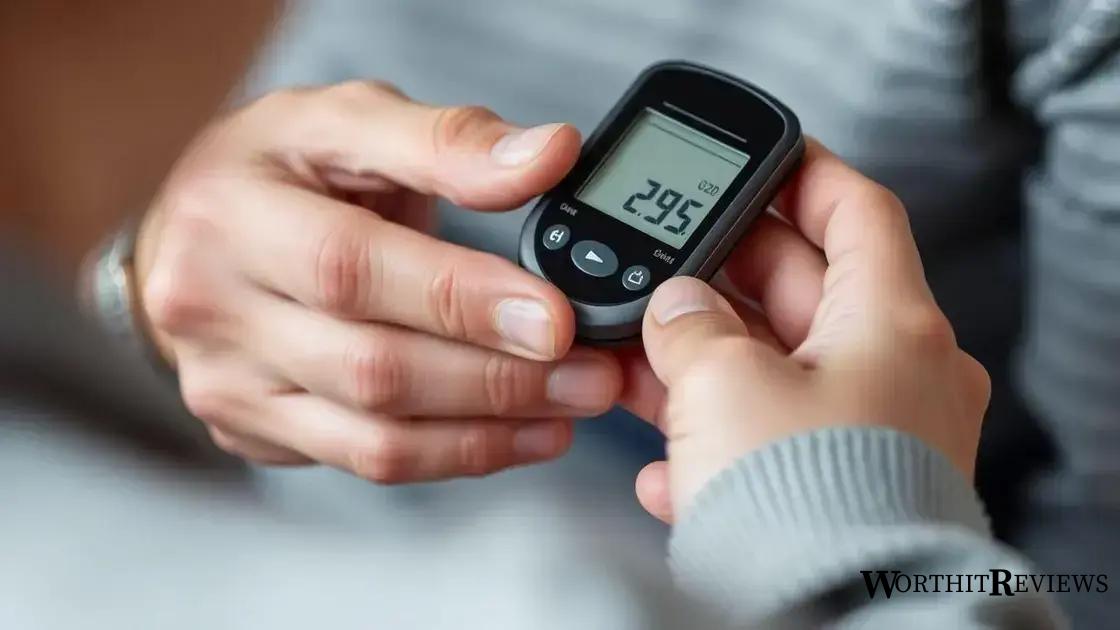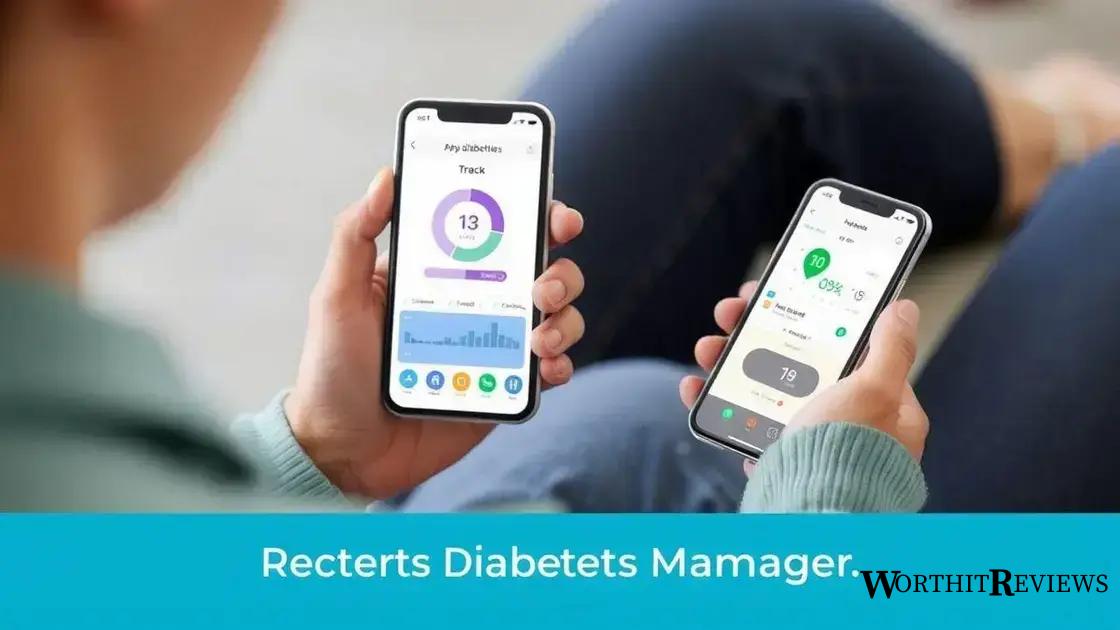Diabetic sugar readings are critical for managing diabetes effectively; monitoring blood sugar levels, maintaining a balanced diet, and utilizing tools like glucose meters and apps can help achieve optimal health.
Diabetic sugar readings play a crucial role in managing diabetes effectively. Ever wondered how those numbers affect your daily life? Let’s dive into why monitoring them is key for your health.
What are diabetic sugar readings?
Diabetic sugar readings are measurements that indicate the amount of glucose in your blood. These readings are essential for managing diabetes effectively and help you understand how your body reacts to food, exercise, and medications.
Typically measured in milligrams per deciliter (mg/dL), these readings inform you whether your blood sugar is within a normal range. For most people with diabetes, maintaining levels between 70-130 mg/dL before meals is important, while readings below 70 mg/dL may indicate low blood sugar, known as hypoglycemia.
Understanding your sugar readings empowers you to make informed decisions about your diet and lifestyle. You may wonder how your activity level and food choices affect these numbers. Regular monitoring is crucial; it helps you to adjust your management plans and communicate effectively with your healthcare providers.
Tools like glucose meters or continuous glucose monitors (CGMs) allow for easy recording of these readings. Many apps can help you track your results and even identify patterns over time.
How to accurately measure your sugar levels

Accurately measuring your sugar levels is vital for managing diabetes effectively. The most common method is using a glucose meter. This device requires a small blood sample, usually obtained from a fingertip prick.
First, wash your hands thoroughly with soap and water, and dry them completely. This helps to avoid any contamination that could affect your reading. Next, insert a test strip into the glucose meter. When ready, use a lancing device to prick your finger. Gently squeeze your finger to obtain a drop of blood and touch it to the test strip.
After a few seconds, the meter will display your blood sugar reading. It’s essential to check the expiration date on test strips and use them before they expire. If you have a continuous glucose monitor (CGM), it can provide real-time blood sugar readings throughout the day, which is especially helpful.
Understanding when to measure your levels is also important. Typically, you should check your sugar levels:
- Before meals
- Two hours after eating
- Before and after exercise
- When feeling unwell or stressed
Regular monitoring will help you recognize patterns and adjust your meal plan and medications as necessary. Keeping a record of these readings will also be beneficial for discussions with your healthcare provider.
Understanding the impact of diet on sugar readings
Your diet plays a crucial role in diabetic sugar readings. The foods you eat directly affect your blood sugar levels. For instance, meals high in carbohydrates can cause spikes in blood glucose. It’s important to be mindful of what you consume.
Foods like whole grains, vegetables, and lean proteins can help maintain stable blood sugar levels. On the other hand, sugary snacks and refined carbohydrates may lead to rapid increases in glucose. Understanding this can empower you to make healthier choices.
Combining foods is another effective strategy. Pairing carbohydrates with protein or healthy fats can slow down the absorption of sugar into the bloodstream. For example, having an apple with peanut butter can be a good combination that helps control sugar spikes.
Additionally, portion control is vital. Eating large portions can elevate blood sugar more than smaller, balanced meals. It can be helpful to track your food intake alongside your sugar readings to see how different foods impact your levels over time.
Staying hydrated is also linked to sugar management. Drinking water regularly can help your kidneys flush out excess sugar through urine. Moreover, using natural herbs and spices, like cinnamon, may also aid in improving insulin sensitivity.
Lastly, consider consulting a registered dietitian. They can create a personalized meal plan tailored to your preferences and health goals.
Recognizing signs of high and low blood sugar

Recognizing the signs of high and low blood sugar is essential for everyone managing diabetes. Understanding these symptoms can help you take action quickly and prevent serious health issues.
When blood sugar is too high, known as hyperglycemia, you may experience:
- Increased thirst
- Frequent urination
- Fatigue
- Blurred vision
- Headaches
These symptoms arise because excess glucose builds up in the bloodstream. If left unchecked, hyperglycemia can lead to more serious conditions like diabetic ketoacidosis.
On the other hand, low blood sugar, or hypoglycemia, can cause different symptoms, including:
- Shakiness or trembling
- Sweating
- Feeling anxious or nervous
- Confusion or difficulty concentrating
- Extreme hunger
Hypoglycemia can happen suddenly, often requiring immediate action. Consuming quick sources of sugar, like fruit juice or glucose tablets, can help bring your levels back to normal.
It’s important to keep track of these symptoms and communicate with your healthcare provider. Keeping a log of your blood sugar readings along with any symptoms you experience can help identify patterns and necessary adjustments in your management plan.
Tips for maintaining optimal sugar levels
Maintaining optimal sugar levels is crucial for people with diabetes. Here are some practical tips to help you manage your blood sugar effectively:
1. Monitor your blood sugar regularly: Keep track of your levels to understand how your body responds to certain foods and activities. Use a glucose meter or continuous glucose monitor to get accurate readings.
2. Follow a balanced diet: Include a variety of foods in your meals, focusing on whole grains, lean proteins, and plenty of fruits and vegetables. This helps stabilize your blood sugar and provides essential nutrients.
3. Control portion sizes: Eating smaller portions can help prevent spikes in blood sugar. Use measuring cups or your hand as a guide for portion control.
4. Stay active: Regular exercise can help improve your body’s sensitivity to insulin. Aim for at least 150 minutes of moderate aerobic activity each week.
5. Stay hydrated: Drinking enough water is important for overall health and can help support your body’s ability to regulate blood sugar.
6. Manage stress: Stress can negatively impact your blood sugar levels. Practice relaxation techniques like deep breathing, yoga, or meditation.
7. Get enough sleep: Quality sleep is essential for overall health and can help stabilize your blood sugar. Aim for 7-9 hours of restful sleep each night.
By incorporating these tips into your daily routine, you can better manage your sugar levels and enhance your overall well-being.
Tools and apps for tracking diabetes effectively

Using the right tools and apps can make managing diabetes much easier. These resources help you track your blood sugar levels, diet, exercise, and overall health.
1. Blood Glucose Meters: These devices measure your blood sugar levels quickly and accurately. Look for meters with Bluetooth capabilities that sync with your smartphone for easy tracking.
2. Continuous Glucose Monitors (CGMs): CGMs provide real-time glucose readings throughout the day. They alert you to spikes or drops in blood sugar, allowing for quicker response times.
3. Diabetes Management Apps: Apps like MySugr, Glucose Buddy, and Carb Manager help you log your food intake, exercise, and blood sugar readings. They often provide insights and trends that help you understand how your habits affect your levels.
4. Health and Fitness Trackers: Devices like smartwatches or fitness bands can monitor your physical activity and heart rate. They encourage you to stay active, which is important for controlling blood sugar.
5. Meal Planning Apps: Tools like Lose It! or MyFitnessPal assist with meal planning and calorie counting. These apps help ensure you’re making healthy food choices based on your nutritional needs.
By leveraging these tools and apps, you can gain better control over your diabetes management and live a healthier life.
Managing Diabetes Effectively
Understanding and managing diabetes involves knowledge and the right tools. From recognizing the signs of high and low blood sugar to maintaining optimal levels through diet and exercise, each step is important.
Utilizing monitoring devices and diabetes management apps can make a huge difference in your daily life. These resources help you track your blood sugar, meal planning, and exercise, leading to informed decisions about your health.
By staying proactive and engaged in your diabetes management, you can improve your quality of life and gain better control over your condition. Remember, small changes can have a big impact on your health.
